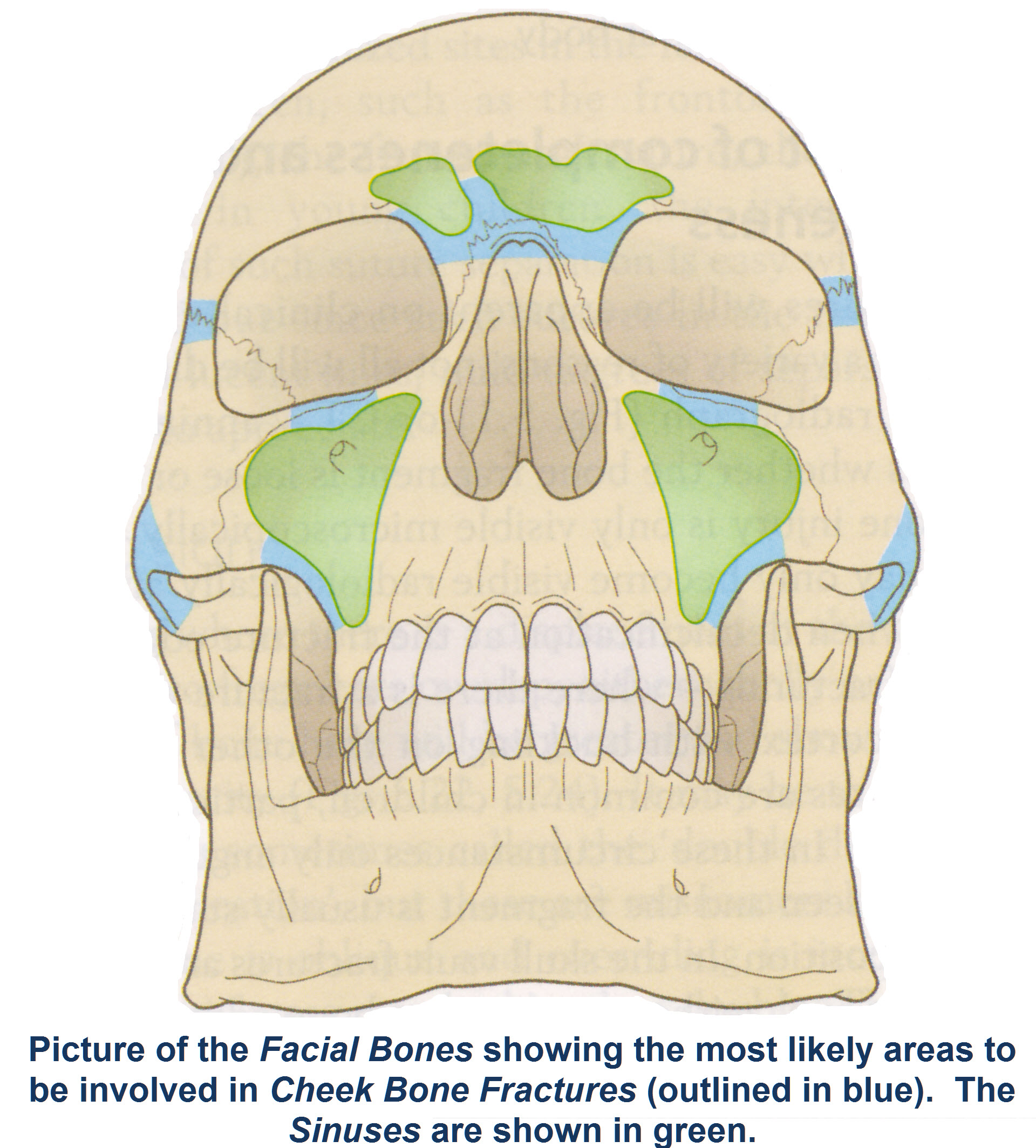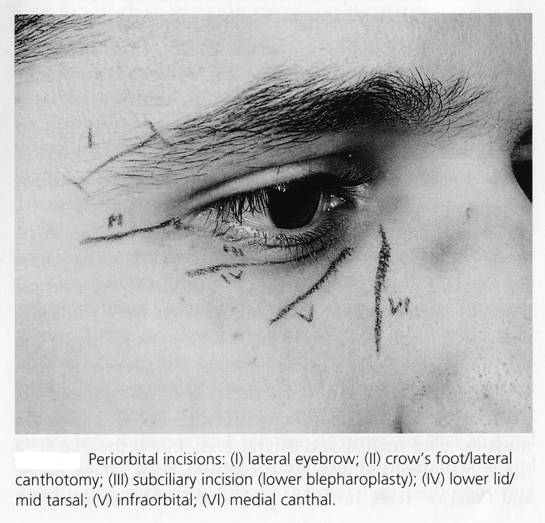Fractures of the Cheek Bone
The Problem
Your cheekbone has been broken.
The cheekbone forms part of the eye socket, both protecting the eyeball and supporting it from below. It is also linked to the side of the nose and the upper jaw.
The number of fractures, where they have occurred and whether they need treatment to help them heal has already been explained to you. The treatment that is about to take place involves a general anæsthetic, i.e.: you will not be conscious during the procedure.

What does the operation involve?
Once you are anæsthetised, the cheekbone will be put back in the right place. This usually involves a small cut about an inch long through the hair in the temple.
Sometimes, this is all that is required but if the surgeon does not feel that your cheekbone will stay in the correct position on its own, it may be necessary to hold it in place with small metal plates and screws.
Putting these plates and screws into the cheekbone may require one or more alternative cuts:
- A cut made close to the outside end of the eyebrow
- A cut made on the inside of the mouth through the gum above the back teeth
- A cut made in the skin crease just below the lower eyelashes or on the inside of the lower eyelid
These cuts are put back together again at the end of the operation with stitches. Stitches on the skin need to be removed after a week but any stitches inside the mouth are usually dissolvable although they can take a fortnight or even longer to fall out.

Will anything else be done while I am anaesthetised?
Some fractures of the cheekbone produce a break in the floor of the eye socket that needs attention. In such cases, a cut on the inside / outside of the lower eyelid is necessary as described above.
Occasionally, the bones in the floor of the eye socket are shattered and do not support the eyeball properly, even if they are put back in the right position. In these circumstances it may be necessary to either “graft”; the floor of your eye socket to support the eyeball or put in a titanium mesh to do the same thing.
The graft material that is going to be used will be discussed with you before you sign any consent form for your operation. However, it can involve thin sheets of plastic or bone grafted from other areas of your body.
What can I expect after the operation?
The area affected is likely to be sore and regular painkillers will be arranged for you. The discomfort is usually worse for the first few days, although it may take a couple of weeks to completely disappear. Cheekbone fractures usually heal without infection but it may be necessary to give you antibiotics, particularly if a “graft” has been used. Initially, it may be necessary to give you antibiotics through a vein in your arm whilst you are in hospital. You will be sent home with painkillers and a course of antibiotics if necessary.
There is usually some swelling and bruising in the skin around the eyelids. Occasionally, the whites of the eyes may become bruised giving them a red appearance. All these changes are most noticeable in the first 24 hours after surgery and will have very much reduced by the end of the second week. Swelling and bruising can be improved by using cold compresses / packet of frozen peas and sleeping propped upright for the first few days after surgery. You usually stay in hospital for one night following the surgery. The following day the position of your cheekbone may be checked with X-rays before you are allowed home.
Even if the fracture has been held in the right place with plates and screws, it still takes around six weeks for your cheekbone to heal completely. During this time, you need to be careful to avoid an injury to this side of your face since it may well push the cheekbone back out of position again.
You should also avoid blowing your nose on the side of the fracture for a month following surgery because otherwise this can produce swelling in and around the eye.
Before you leave hospital, an appointment will be arranged to take out any stitches and review you in the outpatient department. It is important to keep any stitches or dressings dry until they are removed. If you have any incisions inside your mouth, it may be difficult to clean your teeth around the stitches because of soreness. It is best to keep the area free from food debris by gently rinsing your mouth with an antiseptic mouthwash (such as Corsodyl) or warm salt water (dissolve a flat teaspoon of kitchen salt in a cup of warm water) commencing the day after surgery.
Do I need to take any time off work?
Depending on the nature of your work it may be necessary to take a fortnight or so off work and avoid strenuous exercise for this time. It is important to remember that you will not be able to drive or operate machinery for 48 hours after your general anæsthetic.
What are the possible problems?
- Post-op Numbness. There is a nerve (the Infra-Orbital Nerve) that runs through the cheekbone that supplies feeling to the cheek, side of your nose and upper lip.
This nerve may have been bruised at the time of the fracture and as a result you might already feel some tingling or numbness over your face. Tingling may also be caused / made worse by surgery. In the majority of people, the numbness gets better on its own although it may take several months to do so (in some cases, normal sensation never recovers).
- Post-op Bruising & Swelling. There is likely to be swelling and bruising at the operation site post-operatively. These will both settle with time. There is a chance if this occurs around the eye, that you may develop a black eye.
- Post-op Limitation of Mouth Opening. This limitation of mouth opening should improve with time.
- Facial Scarring. Any cuts made on the face will produce a scar, which should fade with time and after a few months become difficult to see.
- Post-op Bleeding. Bleeding can occur from the incision sites, though this is unlikely to be a problem. Should the area bleed when you get home, apply pressure over the site for at least 10 minutes with a rolled up handkerchief or swab.
- Very rarely, bleeding in and around the eye socket can cause a problem with the eyesight immediately following surgery (Retro-bulbar haemorrhage). You will be closely monitored in the first few hours after your operation to make sure that should this happens it is picked up quickly. If you experience worsening vision or pain in and around your eye when you get home you should return to hospital immediately.
- Lower Eyelid Malposition. If a cut is made in the skin of the lower eyelid, the outside corner of the lid may occasionally be pulled down slightly (an ectropion). This tends to settle on its own but may need further surgery.
- Plate Removal. Any plates or screws that it has been necessary to insert in your cheekbone to hold it in position are usually left in place, as they tend not to cause problems. However, the plates are removed if they can be touched and cause discomfort; they cause pain, become infected or loosen. Rarely, in cold weather, the titanium plates can be associated with pain.
- A small minority of people develop, after having their cheek bone repaired, a postoperative sinusitis. This was related directly to the severity of injury.
- Facial Asymmetry. Post-operative facial asymmetry occurs in 20 – 40% of patients. Most postoperative irregularities require no surgical intervention; however, major asymmetry occurs in 3 – 4% of patients. Correction of these cosmetic defects may require further surgery.
Will I need further appointments?
A review appointment will be arranged before you leave hospital. It is usual to keep a close eye on you for several months following treatment to make sure that your fracture heals satisfactorily.
